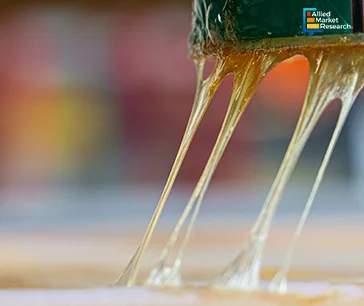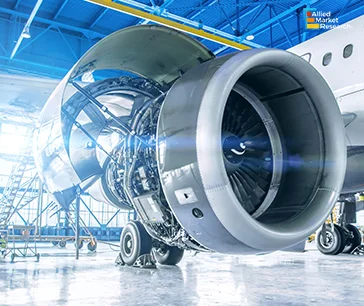Table Of Contents

Lalit Janardhan Katare

Pooja Parvatkar
Revolutions in Aerospace Adhesives Market: A Comprehensive Analysis

Aerospace adhesives constitute indispensable elements within contemporary aviation, playing a pivotal role in both the construction and maintenance of aircraft. Their significance extends beyond bonding functions, including essential contributions to the structural integrity, durability, and overall performance of diverse aerospace components, such as airframes and interior structures. Aerospace adhesives are foundational in ensuring that critical elements of an aircraft maintain their integrity and functionality under the demanding conditions of flight.
The adhesive properties of aerospace adhesives are instrumental in creating strong and reliable bonds between different materials, fostering cohesive and resilient structures. For instance, 3M's "Scotch-Weld™ Multi-Material Composite Urethane Adhesive EC-3500," is designed to foster cohesive and resilient structures. This bonding capability is integral to the industry's emphasis on structural integrity, ensuring that various components withstand the complex and dynamic forces experienced during flight. Aerospace adhesives contribute significantly to the longevity and reliability of aircraft owing to the robustness of airframes and durability of interior components.
Importance of Adhesives in Aerospace Industry
Aerospace adhesives play a central role in advancing the aerospace industry's objectives of achieving lightweight and fuel-efficient aircraft. Hexcel's innovative adhesive solutions such as the BETAFORCE™ composite bonding adhesives, exemplifies this commitment. By minimizing the reliance on traditional mechanical fasteners, these adhesives contribute to weight reduction, a critical factor in enhancing fuel efficiency and optimizing overall aircraft performance. The pursuit of lightweight structures aligns with broader industry trends aimed at improving environmental sustainability, reducing fuel consumption, and addressing the ecological impact of aviation.
Aerospace adhesives such as Bonderite® M-NT 8453™ Aero, Scotch-Weld™ EC-3500, and BETAFORCE™, with their high-performance formulations and specific features, represent a pivotal technological facet in the aerospace industry. Their multifaceted contributions go beyond conventional bonding functions, encompassing aspects crucial for innovation, safety, and the pursuit of environmental sustainability. Owing to rise in technological advancements in the industry, these adhesives remain at the forefront, facilitating progress in the construction, maintenance, and performance optimization of aircraft.

Key Features of Aerospace Adhesives
- Structural Bonding: Aerospace adhesives are fundamental in creating strong bonds between various materials, enhancing the structural integrity of critical components such as wings, fuselage, and interior elements. This bonding capability is crucial for withstanding stress and force encountered during flight operations.
- Weight Reduction: A significant focus of the key players operating in the aerospace adhesives industry is on developing adhesives that facilitate lightweight construction. For instance, Cytec Solvay’s "CYCOM® EP 2752" is an advanced epoxy resin system for aerospace composites, which is lightweight. By minimizing the need for traditional mechanical fasteners, these adhesives contribute to weight reduction, a key factor in improving fuel efficiency and overall aircraft performance.
- Durability and Stress Distribution: Aerospace adhesives aid in distributing stresses across bonded joints, reducing localized stress concentrations. This feature of aerospace adhesives enhances the overall durability of aircraft structures, ensuring that they can withstand the rigors of flight operations and environmental conditions.
Current Technological Advancements
- Nano-Adhesives: Advancements in the nano-adhesive technology enable stronger and resilient bonds at a molecular level, providing enhanced structural performance while reducing the overall weight of bonded components. For instance, Lockheed Martin is involved in the development of nano-adhesives for aerospace applications. They are focused on incorporating nanotechnology to enhance the strength and resilience of adhesive bonds at the molecular level.
- Heat-Resistant Adhesives: As aircrafts encounter various temperature extremes during operation, the development of heat-resistant adhesives is crucial. These adhesives maintain their integrity and bonding strength under high-temperature conditions, contributing to the safety and reliability of aerospace structures. For instance, Boeing invested in R&D of heat-resistant adhesives to address the challenges posed by temperature extremes during aircraft operations. Boeing's use of advanced heat-resistant adhesives in critical areas of their aircraft, such as engine components and thermal insulation, ensures that the adhesives maintain bonding strength under high-temperature conditions, enhancing safety and reliability.
- Environmentally Friendly Adhesives: The industry is increasingly focusing on the development of adhesives with reduced environmental impact. Environmentally friendly adhesives aim to minimize volatile organic compound (VOC) emissions, aligning with the broader industry push towards sustainability. For instance, 3M Aerospace has been at the forefront of developing environmentally friendly adhesives for the aviation industry. 3M's introduction of adhesives with reduced VOC emissions aligns with the industry's sustainability goals. The 3M™ Scotch-Weld™ Low Odor Acrylic Adhesive DP8805NS exemplifies 3M’s commitment to environmentally friendly solutions.
Market Landscape and Developments
The global aerospace adhesives industry is marked by intense competition among key players, prominently featuring industry leaders such as 3M, Henkel AG & Co. KGaA, and Huntsman Corporation. These companies play a central role in shaping the market dynamics, contributing to advancements and innovations in the aerospace adhesives sector.
Recent breakthroughs within the market underscore the commitment of key players to push the boundaries of adhesive technology. For instance, in 2021, Henkel collaborated with Boeing to develop Loctite EA 9365FST, a two-part epoxy adhesive that reinforces and bonds thermoplastic and thermoset substrates and can serve as a matrix resin on fiberglass to strengthen the thin walls of thermoplastic assemblies. Notable advancements include the introduction of advanced adhesive formulations. These formulations prioritize key attributes such as enhanced bonding strength, increased durability, and greater adaptability to a diverse range of materials used in aerospace applications. For instance, in 2022, Solvay launched Aero-Paste 1006, 1009 and 1100 adhesive pastes and BR 179 non-chromate primer, which is designed to increase the part assembly efficiency and provide flexibility. Also, Solvay introduced FusePly 250, a new addition to its chemical bonding technology, which is designed for aerospace manufacturing. This product complements the existing FusePly 100 (now renamed FusePly 350) and is tailored for bonding composite structures at 250°F and higher.

The competitive landscape, marked by continuous innovation and breakthroughs, reflects the industry's dedication to staying at the forefront of adhesive technology. The key players' role in introducing advanced formulations influence their market positioning as well as contribute significantly to the overall progress and evolution of aerospace adhesives, thus enhancing safety, efficiency, and performance of aircraft structures globally.
Future Market Outlook
The future of the global aerospace adhesives market holds promising possibilities:
- Innovative Formulations: Ongoing research is poised to yield adhesive formulations with enhanced performance characteristics, addressing specific requirements in aerospace applications. Rise in innovations aim to elevate standards in structural integrity, durability, and efficiency, aligning with the dynamic challenges such as weight reduction for fuel efficiency, structural integrity, high-temperature resistance, compatibility with wide range of advanced materials, environmental sustainability, and others of the aviation industry. Below are few examples of the innovative formulations:
- Henkel Corporation: Henkel's line of aerospace adhesives includes products such as Loctite EA 9394 AERO, which has high temperature resistance for aerospace applications, and it enhances durability and structural integrity
- 3M Aerospace: 3M offers innovative products such as Scotch-Weld™ Structural Adhesive Film AF 163-2K, which is an advanced film adhesive for composite bonding and is also suitable for a range of aerospace materials.
- Digital Integration: The future of aerospace adhesives involves increased integration with digital technologies, particularly the incorporation of sensors for real-time monitoring. This digital integration facilitates improved adhesive performance assessments, contributing to the implementation of predictive maintenance strategies. The shift towards a data-driven approach enhances operational efficiency and extends the lifespan of adhesive-bonded structures. For instance, Henkel incorporated IoT sensors in its aerospace adhesives to monitor curing processes. These IoT sensors provide real-time data on curing times, reducing variability by 15% and ensuring consistent adhesive performance. In addition, 3M utilizes RFID technology to track adhesive application and curing details for bonded structures. Therefore, this results in a 20% reduction in time spent on manual tracking processes, improving overall manufacturing efficiency.
- Sustainability Focus: The aerospace industry's ongoing commitment to sustainability is anticipated to drive the development of adhesives with reduced environmental impact. This focus aligns with broader industry goals, fostering the creation of adhesives with eco-friendly attributes. Developments in the industry reflect the sector's dedication to environmental responsibility, addressing concerns related to the ecological footprint of aerospace activities and contributing to a more sustainable aviation landscape. For instance, Henkel has been actively working on sustainable solutions in the aerospace sector. It hasIt has introduced a range of adhesives and sealants, such as Bonderite® M-NT 8453™ Aero, designed with a focus on environmental responsibility. Moreover, Dow is involved in the aerospace sector and has introduced sustainable adhesive solutions such as BETAFORCE™ composite bonding adhesives.
Looking Ahead
In conclusion, the aerospace adhesives market is set for substantial growth, fueled by the aerospace industry's priorities of safety, efficiency, and sustainability. Ongoing advancements in adhesive technology are anticipated to drive this expansion, providing tailored solutions that align with the evolving demands for safety, efficiency, and sustainability of the aerospace sector. Innovations in adhesive are expected to play a crucial role in enhancing structural integrity, meeting stringent safety standards, and contributing to the industry's pursuit of lightweight, fuel-efficient aircraft.

Efficiency gains, achieved through lightweight materials and advanced bonding solutions, position aerospace adhesives as key contributors to optimized aircraft performance and reduced fuel consumption. In addition, the market's responsiveness to sustainability concerns is evident in the development of eco-friendly adhesives that align with environmental goals. As the aerospace industry continues to prioritize innovation, the adaptive nature of adhesive technologies will be pivotal in shaping the industry's trajectory toward heightened safety, efficiency, and sustainability.
For further insights, get in touch with AMR analysts.

